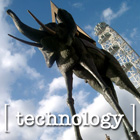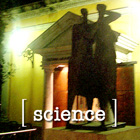
|
||||||||||||||||||
|
QUANTUM STABILITY FROM GRAPHENE'S 'PERFECT' CRYSTAL FILM REMARKABLE CARBON CRYSTAL LATTICE, DERIVED FROM PENCIL 'LEAD', CAN PERMIT EXPLORATION OF QUANTUM PROPERTIES OF NEUTRON STARS 21 July 2006 Philip Ball reports in the New Scientist that discoveries in the quantum properties of graphene, a single-atom-thick sheets of interlinked carbon atoms may hold the secret to superfast computing, beyond the physical capacity of silicon. The unique material is obtained by flaking or peeling individual sheets away from graphite. The molecular structure of silicon is such that it can translate reliably into nano structures only so small and no smaller. Graphene exhibits remarkably strong covalent bonds holding each cabron atom to 3 others, forming a uniform plane of hexagonal crystal lattice. That reliable and unique uniformity means that electrons moving through a sheet of graphene "can travel immense distances without scattering, opening up the possibility of ultra-fast electronics." The quantum properties of graphene also prevent the seepage quantum mechanics predicts for silicon nano-transistors, avoiding short-circuits and breakdown at high processing speeds. What's more, as Ball reports in the New Scientist, electrons being charged particles "communicate" and can act together as "quasiparticles", and graphene's smooth composition allows these quasiparticles to behave like electrons traveling at nearly the speed of light. Such phenomena occur normally only near neutron stars or in a singular event like the Big Bang. Their occurence in graphene will permit not only brave new frontiers in computing speed, but also experiments into theoretical physics not feasible by any other means. Ultimately, the practical applications require a lot of technological advancement and may be a long way off, a matter of decades, but graphene is thought to be a definite boon to physicists. It may be possible to test many of the most problematic aspects of quantum physics and gain a new understanding of the Big Bang and the origins of our own universe. [s]
BACKGROUND: The 'universe' we know as all-encompassing, the vague, probably never to be finally defined concept of the structure of physical reality, may actually be one of many such distinct self-contained, self-sustaining phenomena, with distinct physical properties and corresponding physical laws and tendencies, unified membrane cosmologies adrift in a 'superfluid' soup, at times colliding with incredible energy diffusion, creating whole new universes. [Full Story] SCIENCE SAYS EVOLUTION WORKS The journal Science, in selecting its breakthrough of the year, decided to feature a series of scientific advances demonstrating how evolution works. At the end of a year that has seen a growing marginal movement in the US to displace evolution as mere conjecture in favor of the untested, religiously based "intelligent design" argument, Science intends to proactively defend science, as such. [Full Story] |
|||||||||||||||||
|
||||||||||||||||||









